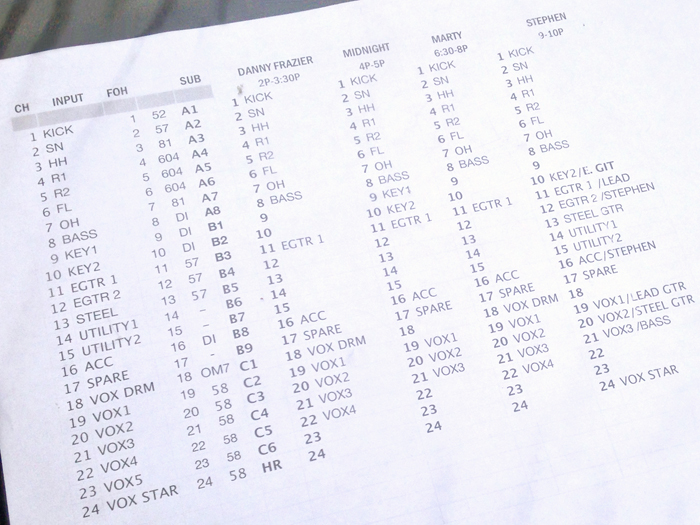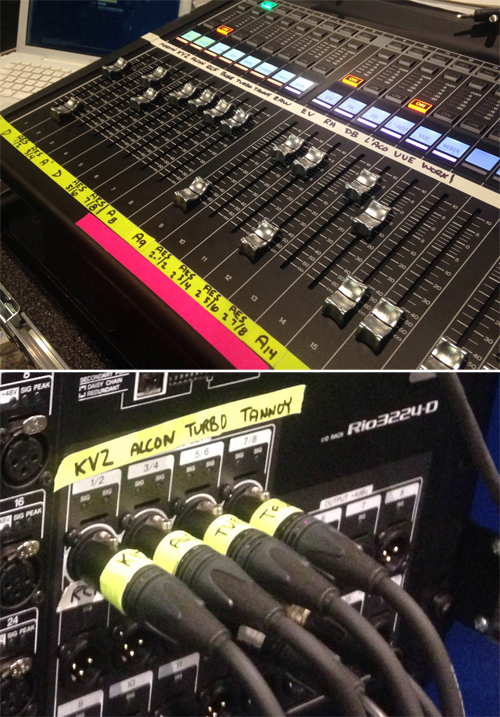Being organized and prepared ahead of the gig is a huge key for the independent audio practitioner, a.k.a., Lone Audio Ranger.
As I write this article, I’m smack dab in the middle of a multi-day, mixed programming event – a live outdoor cooking show with lots of wireless, video playback, record feeds, musicians, and emcees. This event is impeccably organized with everyone on the same page, and for the most part, happy. I chalk it up as a success.
Yet this is rarely the scenario with other events. Early in my career, I was the house engineer at a small theater that featured a diverse range of programming – local and touring musical artists, corporate functions, weddings, comedy shows, and whatever else the promoter could dream up.
I faced the common scenario of being presented with a schedule of shows, and if I was lucky, a heads-up on specifics like time, technical needs, and contact information. But the most relevant and critical information was rarely passed along. It left me guessing, unprepared, and stressed.
Both of these scenarios are a direct result of good communication – or lack thereof. The big message: most of these issues can be solved with a quick phone call or short e-mail, simple things that nonetheless result in a much better outcome.
Proactive Not Reactive
Asking the right questions, listening, clarifying and ultimately developing a plan is the goal. The plan can be written down, developed into a fancy spreadsheet, or simply worked out in your head. When advancing details for any event, start by gathering and confirming the accuracy of the following details:
—Date and time, including load-in/load-out
—Layout, stage plots, input lists, and other technical details/requests
—Day-of-show – and if applicable – run-of-show schedule
—Special requests or out-of-the-ordinary challenges
—Who writes the check
Technical documents from performers or clients come in many different styles. (I recently received “stage plot” via text, which was a phone screen shot of a handwritten stage layout cartoon.) Regardless, stage plots and input lists are very helpful, in whatever format and/or delivery.
Do your best to confirm that the documents you’re working from are up to date and accurate for the event you’re advancing. Obviously these documents can serve as a generic “one size fits all” solution, but it’s always good practice to confirm the accuracy for your specific event.
If working with multiple bands, entertainers, or presenters, work out a patch and gear allocation that covers all of your needed inputs. A “festival patch” can be very helpful. It’s also very helpful to have the contact name listed on the documents, as well as performance times and special notes.
I like to keep this patch sheet on the outside cover of my event binder while inside, there’s a day-of-show schedule listing the day’s timeline and activities as well as run-of-show documents detailing a “play by play” for corporate and mixed programming events and relevant stage plots.
Invariably, we’re still faced with situations where there are little to no advance details (i.e., last-minute one-offs). On-site prior to the event, I’ll ask the technical director, client, band or anyone who seems to be in-the-know to tell me the essentials – at least inputs and outputs – and record these in a small spiral-bound notebook that I keep handy.
I then work off that “needs list” to assemble my game plan, checking each one off as it’s completed.
On a related note, when dealing with clients, it’s vital to be clear and honest about what you can and cannot provide. Don’t promise resources, gear, or time to do a proper job if you’re unable to do so. There are always workarounds and room for compromise, and this is where negotiation skills will come in handy, not to mention the ability to be flexible.
On The Stage
With the administrative details managed, let’s get into some key hands-on technical tips for the stage to help the day (and event) flow smoothly. I can never stress enough the importance of labeling and cable management.
One of my top recommendations is to start any cable run from the patch and then out to the source or output. This leaves slack on the source side (microphone, DI, podium, etc.) and not at the patch side, which can quickly turn into “spaghetti city.” The “patch” can be the console, snakehead, sub-snake, floor pocket, and so on. This way, if the source or powered loudspeaker needs to be moved, you have the slack to do so.
Another tip that’s saved me time, again and again: labeling. It makes life so much easier when things go wrong, which they inevitably will. You want to know “what’s what” with a cable without having to unnecessarily trace the line. I simply use either a light colored electrical tape or spike/Gaff tape (by the way, electrical tape will help that fine point of your Sharpie last much longer). I’ve found masking and painters tape to be poor choices for the job.
For inputs, like microphones and DIs, label the female end of the XLR. For outputs/returns, label the male XLR end. Same goes for monitors. It’s good practice to label the grills of monitors/wedges with the mix number, as well as the NL4 or XLR drive connectors.
In addition to cabling, label the console, sub-snakes, wireless receivers, and any other item that requires instant identification. In the heat of the battle, you’ll know what you need to know at a glance. (For more in this regard, I highly recommend “Stagecraft: Wiring The Stage Efficiently & Safely” by Alex Fernie here on ProSoundWeb.)
What Works For You
Although the role of the Lone Audio Ranger can be trying at times, you have the unique freedom to create solutions that work best for you. In the next installment, I’ll delve into success in the freelance world – tips to manage and grow your career. Have fun and keep that attitude positive!

















